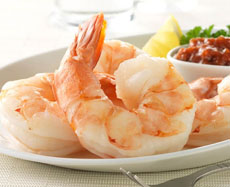

Experiment with different types of liquid for your brine. Photo courtesy Butterball.
|
BERNADETTE MARCINIAK is an editorial intern at THE NIBBLE.
|
|
December 2009
|
 |
Brining: It’s Not Just For Turkey!
Page 2: How To Brine
This is Page 2 of a two-page article. Click on the black links below to visit Page 1.
How To Brine
In most basic terms, brining means to soak your meat in salt liquid. There should be one cup of salt for every gallon of liquid used for your brine solution.
While both regular table salt and kosher salt will do, kosher salt is actually cleaner and doesn’t have as many additives as table salt. It also dissolves into the meat more because it’s airier.
Despite popular belief, water does not need to be the liquid of choice used for brining solutions.
Kyle Shadix, director of nutrition and culinary services for Nutrition + Culinary Consultants, says, “brining food causes a significant increase in sodium and although it is a great technique,” the benefits of brining don’t outweigh the high salt content.
Instead, Chef Kyle says he replaces the water with another liquid, such as apple cider or orange juice (beer and vinegar work as well!). And, he substitutes excess salt with dried herbs, such as thyme or sage. “It’s more of a modified, less-sodium brine,” he says, “but it is the salt that makes it juicy!”
Most people are wary of using a liquid other than water because after the brining is done, the solution has served its purpose, and is thrown out. But if you’re willing to go the extra mile for a delicious meal, it could be worth it. Just be weary of the liquids you choose; brines that come from vinegar—like lemon juice, for example—will make your meat acidic, and you run the risk of turning it extremely mushy.
So to start, what you’ll need is a container or bag big enough to hold enough liquid to fully submerge the entire cut of meat (be it whole or in parts). Every square inch of meat should be covered in the solution. One of the functions of brining includes sterilization: The salt kills the bacteria, so if any part of the meat is left in the air, it won’t work.
(NIBBLE TIP: Start brining the night before you plan to cook the meat so it’ll be ready for cooking the morning you plan to serve it for dinner.)
Stir in salt and sugar, if desired, to boiled water and toss in any herbs or spices for seasoning. Let the water cool before submerging the meat because you don’t want the brine solution to be hot enough to begin cooking the meat. If there isn’t enough solution to fully cover the meat, simply add cold water until it’s fully submerged along with any juices or fruits to further flavor the meat. Then, put the meat in the refrigerator.
The length of time you keep your meat in the solution depends on how big or heavy the meat is.
The best formula to go by is one hour per pound of meat, meaning if you have a 10-pound turkey, you’re going to have to soak the bird in the brine for about 10 hours. Because they’re much smaller than turkey, peeled shrimp will be ready to go after about 30 minutes. Unpeeled shrimp need about an hour in the brine solution. |
|
 Brining draws extra moisture out of the shrimp flesh, thus firming it's texture. Photo courtesy Allen Brothers. Brining draws extra moisture out of the shrimp flesh, thus firming it's texture. Photo courtesy Allen Brothers. |
After the meat sits in the brine for the appropriate period of time, simply take it out of the brine solution and start cooking. No rinsing is necessary unless the brining solution is heavily salted.
Also keep in mind that an unfortunate (or maybe fortunate, depending upon what your desired result is) side effect of brining is that the skin won’t crisp on chicken or turkeys when it’s so moist. Therefore, if you’d like a crispy skin on your meat you can “air-dry” it after brining to let water evaporate on the surface. Air-drying entails leaving the meat uncovered in the fridge—overnight for whole birds, or for a few hours for meat parts.
Brining is a game of experimentation that you can try many different ways. In the end, you will want to use whichever method works best for you. Happy brining!
Go To The Article Index Above
Lifestyle Direct, Inc. All rights reserved. Images are the copyright of their respective owners.

|





